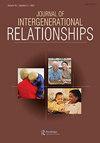The Impact of the First COVID-19 Stay-at-Home Restrictions on Intergenerational Interactions
IF 1.1
Q3 GERONTOLOGY
引用次数: 0
Abstract
ABSTRACT To explore intergenerational differences in the impact of the initial COVID-19 restrictions on interactions, loneliness, and stress, data were collected via online survey from 962 individuals between April 7-May 8, 2020. The predominantly female, White, and well-educated sample included 245 younger adults (YAs), ages 18–34; 374 middle-aged adults (MAs), ages 35–64; and 343 older adults (OAs), ages 65 and above. Face-to-face interaction between generations did decrease significantly, while connections via technology increased somewhat less. About a third of MAs (35%) and OAs (36%) were lonely, compared to 48% of YAs (p = .003), and a higher percentage of YAs (57%) reported being “more lonely” now, compared to MAs (36%) and OAs (41%). OAs reported the least stress; 42% reported low/very low levels of stress compared to YAs (9%) and MAs (20%). Physical exercise and “being in nature” were most often used by all generations to deal with stress. Results suggest the resilience of older adults is helping them during the pandemic.第一次新冠肺炎居家限制对代际互动的影响
为了探讨COVID-19初期限制对互动、孤独和压力影响的代际差异,研究人员在2020年4月7日至5月8日期间通过在线调查收集了962人的数据。主要是女性、白人和受过良好教育的样本包括245名年龄在18-34岁的年轻人(YAs);35-64岁中年人374人;以及343名65岁及以上的老年人(OAs)。几代人之间面对面的交流确实显著减少,而通过科技手段进行的联系增加得稍微少一些。大约三分之一的ma(35%)和oa(36%)是孤独的,相比之下,48%的ya (p = 0.003),更高比例的ya(57%)报告说现在“更孤独”,相比ma(36%)和oa(41%)。oa报告的压力最小;42%的人表示压力水平较低或非常低,而青年(9%)和青年(20%)的压力水平较低。体育锻炼和“亲近自然”是各代人最常用的减压方式。结果表明,老年人的适应力在大流行期间帮助了他们。
本文章由计算机程序翻译,如有差异,请以英文原文为准。
求助全文
约1分钟内获得全文
求助全文
来源期刊

Journal of Intergenerational Relationships
GERONTOLOGY-
CiteScore
2.80
自引率
14.30%
发文量
31
期刊介绍:
The Journal of Intergenerational Relationships is the forum for scholars, practitioners, policy makers, educators, and advocates to stay abreast of the latest intergenerational research, practice methods and policy initiatives. This is the only journal focusing on the intergenerational field integrating practical, theoretical, empirical, familial, and policy perspectives.
 求助内容:
求助内容: 应助结果提醒方式:
应助结果提醒方式:


